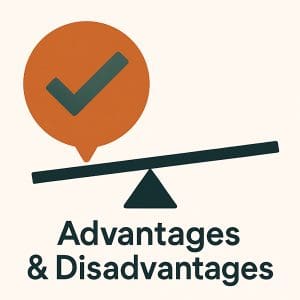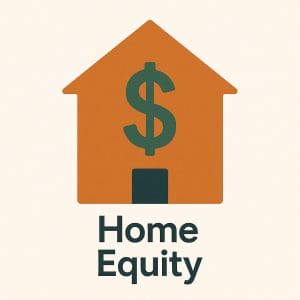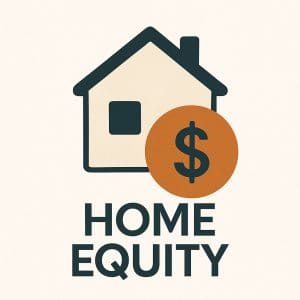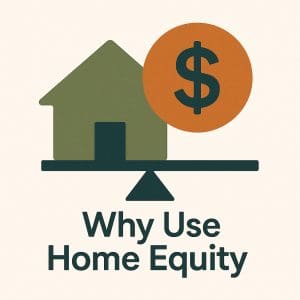Reverse Mortgage vs HELOC (Home Equity Line Of Credit)
Quite often the decision about whether or not to get a reverse mortgage involves choosing between this and a Home Equity Line Of Credit (often called a ‘HELOC’).
In this article I’ll compare the 2 products, so you can decide for yourself – as well as suggest a strategy that I think may be the perfect solution…
You can watch the video version of this where I’ll walk you through everything, or read the full article below the video.

Advantages & Disadvantages Of Both Options
Firstly, let me point out what you probably already know in that a Home Equity Line Of Credit has significant disadvantages:
- You are still required to make the monthly interest payments, you could still lose your home if you do not keep up payments
- You could end up owing more than what your house is worth in the event of a housing market crash
- You need to have income and supporting credit to qualify for it.
In terms of rate, the decision is quite close – sometimes reverse mortgage rates are higher, sometimes they are lower.
My view is that in the long-run HELOC rates may end up being slightly lower than reverse mortgage rates – but it will be close.
However, the one advantage that a Home Equity Line Of Credit (HELOC) has is that it doesn’t eat into the equity of your home – the inheritance you’d be leaving for your family.
That is, for every $100 of interest in a reverse mortgage, the equity (which is the amount of your home that you actually own) decreases by $100.
Of course, your home can grow in value to offset this $100 interest cost but it’s still a factor to think about.
This is not the case with a Home Equity Line Of Credit as you’d be repaying this $100 every month instead.
You’re still out $100 – the choice is using your own money or your home equity to pay it.
Full Comparison Table
Here is a quick summary of what we’re talking about and what you need to think about when deciding between these 2 products:
| Reverse Mortgage | Home Equity Line Of Credit (HELOC) | |
|---|---|---|
| How Much Can you Get? | Up to 55% of your home's value - usually around 10% to 55% - the amount depends on your age and location | Up to 65% of your home's value - usually 10% to 65% - the amount depends on your income and credit score |
| Monthly Payments | Voluntary - can pay interest only or nothing | Mandatory - must pay the interest charge every month |
| Can You Lose Your Home? | Never, under any circumstances | Yes, if you fail to keep up with payments |
| Can The Balance Owed Be Greater Than The Value Of Your Home? | No, the contract specifically outlines that you can never owe more than the value of your home | Technically yes - the balance owed is not capped or reduced under any circumstances other than repayment |
| Do You Need Income And A Good Credit Score To Qualify? | No, you and any spouse living in the home must be over 55 to qualify - that's all | Yes - HELOCs are assessed on your income and credit score - you are required to qualify for one. |
| Can You Repay The Oustanding Balance? | Yes - but penalties will apply that are particularly high in the first 3 years | Yes - can be repaid at any time |
| What Happens When A Homeowner Passes Away? | Nothing - the remaining homeowner keeps the reverse mortgage | The remaining homeowner will be required to prove they have enough income & strong enough credit to keep the HELOC |
| What Happens When Both Homeowners Pass Away? | The balance including the interest becomes payable & will be settled through your Estate - you cannot inherit a reverse mortgage | The balance becomes payable & will be settled through your Estate - you cannot inherit a HELOC |

Another Option: Turning A Reverse Mortgage Into A Home Equity Line Of Credit
I regularly advice folks that they can create a product themselves that has all the benefits of a HELOC with none of the down-side.
How?
What people don’t consider is that you can make voluntary repayments to the reverse mortgage – including repaying the interest.
So what you can do is set up a manual repayment every month to pay the interest on your reverse mortgage.
That way, exactly the same as with a HELOC, the balance owing will never increase as you are covering the interest.
You are basically turning the reverse mortgage into a Home Equity Line Of Credit by doing this.
And it’s much more flexible since the payments are voluntary with a reverse mortgage (so you could choose to skip them, if you needed to) as opposed to mandatory with a HELOC.
I call this ‘The Reverse Mortgage Home Equity Line Of Credit’ (RMHELOC).
Such a product doesn’t exist, it’s more a strategy that you are setting up it by making this voluntary payment of the interest each month (or whenever you feel like it).
You could also create a hybrid reverse mortgage / HELOC – where you make the monthly payment for (say) 6 months of the year but let the interest just accrue the other 6 months – you have full flexibility in how you want to approach this.
That is, with a ‘RMHELOC’ you get all the benefits of a Home Equity Line Of Credit with none of the down-side…

Other Ways To Use Your Home Equity
For more detail on exactly what is a reverse mortgage and how it differs in full to a Home Equity Line of Credit – please download my free reverse mortgage guidebook.
The following article also discusses different ways to use the money: 8 interesting ways to use a reverse mortgage.
In addition to consider how to use this, compared to a HELOC, this article looks at the costs involved for both: costs and fees of a reverse mortgage.

So Why Would You Take Out A HELOC?
This is the big question. In reality, if you are under 55 or want more money out of your home than you qualify for – then these are the main 2 reasons you should consider a HELOC.
You also need to consider the Estate planning consequences in a HELOC – if one of the homeowners were to pass away, the other must then requalify for the amount in full (see the comparison table above) – this is an important aspect for retirees where a reverse mortgage provides a much better solution.
In addition to this, if you are over 55, you could set up the above ‘RMHELOC’ strategy that I discussed above and get all the benefits of a HELOC with none of the down-side.
It just requires a little bit more work to set-up since you are voluntarily making these payments.
However, this gives you increased flexibility in that the payments are voluntary.
You can choose to ‘borrow’ more equity from your home at any point by not making this payment.
So for those of you who are stuck between comparing a reverse mortgage vs HELOC – we hope you’ll consider the above product that we invented: The ‘RMHELOC’ – the basis of which we explained in this article on turning a reverse mortgage into a line of credit.

Get A Free Reverse Mortgage Assessment In 90 Seconds
If you’re interested in seeing if a reverse mortgage is right for you, exploring your options or simply looking for the best deal on a reverse mortgage, I’ll give you a free assessment and advise you if this is a good solution for you, or if something better works.
I’ll also recommend the lender who can give you the best deal in terms of costs and rate.
All it takes is 90 seconds – again, it’s completely free – simply go to:
ReverseMortgagePros.ca/Assessment

A Canadian Chartered Accountant and licensed Mortgage Professional – creator of Reverse Mortgage Pros – the #1 reverse mortgage specialists in Canada. I make it my mission to educate Canadians about how reverse mortgages work so that you can make an informed and educated decision that’s right for you and your family.
Similar Articles

October 4, 2025
The Biggest Mistake You Can Make With A Reverse Mortgage
Lately, I’ve noticed that many people are making the same mistake when it comes to their reverse mortgage decisions. This mistake is choosing a short reverse mortgage term of 6 months, 1 year, 2 years, or even 3 years. This can be a costly choice, and in this blog post, I’ll explain why selecting a… Continue Reading The Biggest Mistake You Can Make With A Reverse Mortgage
Read More >

Reverse Mortgage Costs And Fees
Quite often we get asked the question about what hidden or buried costs there are in a reverse mortgage. This is largely because the whole product can come across of having a feeling of being too good to be true. Being skeptical like this is a good thing considering how many financial products out there bury… Continue Reading Reverse Mortgage Costs And Fees
Read More >

Pros And Cons Of A Reverse Mortgage
In this article we thought we would outline the real pros and cons of a reverse mortgage – updated with the new reverse mortgage rules and lenders. Like any financial decision, there are both advantages and disadvantages that need to be considered. As the leading specialists in Canada, we believe in objectively showing you both… Continue Reading Pros And Cons Of A Reverse Mortgage
Read More >
